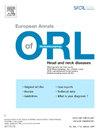Trigeminal cervical complex: A neural network affecting the head and neck
IF 2.4
4区 医学
Q2 OTORHINOLARYNGOLOGY
European Annals of Otorhinolaryngology-Head and Neck Diseases
Pub Date : 2025-07-01
DOI:10.1016/j.anorl.2024.09.008
引用次数: 0
Abstract
Objectives
To introduce the trigeminal cervical complex (TCC) as a comprehensive framework for understanding the anatomical and functional scope of the afferences and efferences of the trigeminal nerve and explaining common otolaryngologic symptoms, including head and neck myofascial pain syndrome. Additionally, it explores how the bidirectional transmission of neurotransmitters contributes to the sensitization of the TCC and motor nuclei.
Methods
The study was conducted as a narrative review. The authors performed a comprehensive search of multiple databases, including Medline/OVID, Embase, Scopus, and PubMed, covering publications from inception until August 2023. Both keywords and medical subject headings related to the TCC were utilized in the search. Information from 66 studies was extracted based on predetermined inclusion and exclusion criteria.
Results
This review discusses the multiple afferent connections from cranial nerves, specifically VII, IX, X, and XI, to the TCC, and their respective efferent pathways. These connections may explain various clinical manifestations in the head and neck that cannot be attributed to other medical conditions. Additionally, the review highlights the dual sensory and motor nature of cranial nerves, emphasizing the bidirectional transmission of neurotransmitters in head and neck areas, which leads to the sensitization of both the TCC and motor nuclei innervating the cervicofacial muscles.
Conclusion
The authors hypothesize that the central and peripheral sensitization and the intricate connections of the TCC can elucidate the pathophysiology of conditions such as otalgia, tinnitus, hearing loss, vertigo, headache, cervicogenic dizziness, bruxism, and other symptoms affecting the head and neck.
三叉神经颈复合体:影响头颈部的神经网络。
目的:介绍三叉神经颈复合体(TCC),将其作为一个综合框架,用于理解三叉神经影响和效应的解剖和功能范围,并解释常见的耳鼻喉科症状,包括头颈部肌筋膜疼痛综合征。此外,它还探讨了神经递质的双向传递如何导致三叉神经丛和运动核的敏感化:本研究以叙述性综述的形式进行。作者对 Medline/OVID、Embase、Scopus 和 PubMed 等多个数据库进行了全面检索,涵盖了从开始到 2023 年 8 月的出版物。检索中使用了与 TCC 相关的关键词和医学主题词。根据预先确定的纳入和排除标准,提取了 66 项研究的信息:本综述讨论了从颅神经(特别是第七、第九、第十和第十一颅神经)到 TCC 的多种传入连接及其各自的传出通路。这些联系可以解释头颈部的各种临床表现,而这些临床表现无法归因于其他疾病。此外,这篇综述还强调了颅神经的感觉和运动双重性质,强调了头颈部神经递质的双向传递,这导致了 TCC 和支配颈面部肌肉的运动神经核的敏感化:作者推测,TCC 的中枢和外周敏化以及错综复杂的联系可以阐明耳痛、耳鸣、听力损失、眩晕、头痛、颈源性头晕、磨牙症等影响头颈部症状的病理生理学。
本文章由计算机程序翻译,如有差异,请以英文原文为准。
求助全文
约1分钟内获得全文
求助全文
来源期刊

European Annals of Otorhinolaryngology-Head and Neck Diseases
OTORHINOLARYNGOLOGY-
CiteScore
3.70
自引率
28.00%
发文量
97
审稿时长
12 days
期刊介绍:
European Annals of Oto-rhino-laryngology, Head and Neck diseases heir of one of the oldest otorhinolaryngology journals in Europe is the official organ of the French Society of Otorhinolaryngology (SFORL) and the the International Francophone Society of Otorhinolaryngology (SIFORL). Today six annual issues provide original peer reviewed clinical and research articles, epidemiological studies, new methodological clinical approaches and review articles giving most up-to-date insights in all areas of otology, laryngology rhinology, head and neck surgery. The European Annals also publish the SFORL guidelines and recommendations.The journal is a unique two-armed publication: the European Annals (ANORL) is an English language well referenced online journal (e-only) whereas the Annales Françaises d’ORL (AFORL), mail-order paper and online edition in French language are aimed at the French-speaking community. French language teams must submit their articles in French to the AFORL site.
Federating journal in its field, the European Annals has an Editorial board of experts with international reputation that allow to make an important contribution to communication on new research data and clinical practice by publishing high-quality articles.
 求助内容:
求助内容: 应助结果提醒方式:
应助结果提醒方式:


